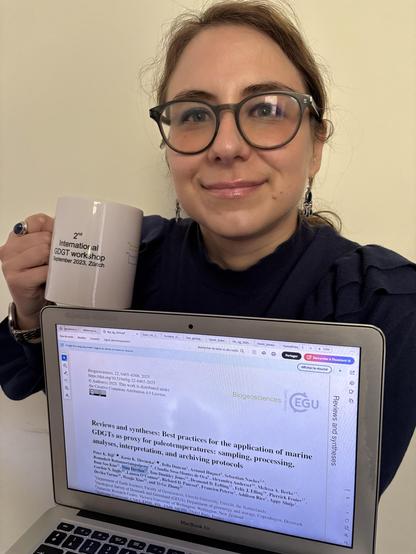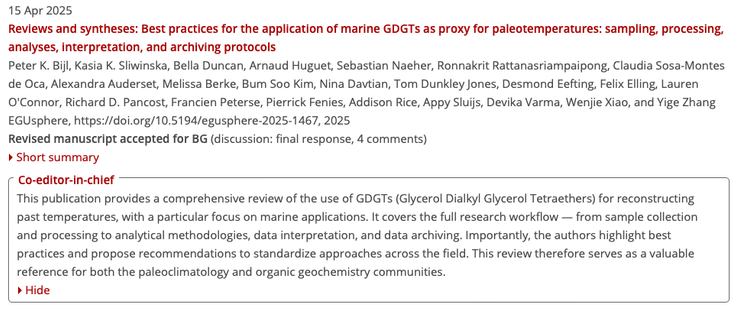

Reviews and syntheses: Best practices for the application of marine GDGTs as proxy for paleotemperatures: sampling, processing, analyses, interpretation, and archiving protocols
Abstract. Marine glycerol dialkyl glycerol tetraethers (GDGTs) are used in various proxies (such as TEX86) to reconstruct past ocean temperatures. Over 20 years of improvements in GDGT sample processing, analytical techniques, data interpretation and our understanding of proxy functioning have led to the collective development of a set of best practices in all these areas. Further, the importance of Open Science in research has increased the emphasis on the systematic documentation of data generation, reporting and archiving processes for optimal reusability of data. In this paper, we provide protocols and best practices for obtaining, interpreting and presenting GDGT data (with a focus on marine GDGTs), from sampling to data archiving. The purpose of this paper is to optimize inter-laboratory comparability of GDGT data, and to ensure published data follows modern open access principles.

Investigating paleotemperature proxies based on archaeal hydroxylated tetraether lipids
Understanding past sea surface temperatures (SSTs) is crucial for reconstructing Earth's climate history. Devika Varma has focused her PhD research pr…

Utilizing Probability Estimates from Machine Learning and Pollen to Understand the Depositional Influences on Branched GDGT in Wetlands, Peatlands, and Lakes
Abstract. Branched glycerol dialkyl glycerol tetraethers (brGDGTs) serve as critical molecular biomarkers for the quantitative reconstruction of past environments, ambient temperature and pH across various archives. Despite their success, numerous issues persist that limit their application. The distribution of brGDGTs varies significantly based on provenance, resulting in biases in environmental reconstructions that rely on fractional abundances and derived indices, such as the MBT’5ME. This issue is especially significant in shallow lakes, wetlands, and peatlands within semi-arid and arid regions, where ecosystems are sensitive to diverse environmental and climatic factors. Recent advancements, such as machine learning techniques, have been developed to identify changes in sources; however, these techniques are insufficient for detecting mixed source environments. The probability estimates derived from five machine learning algorithms are employed here to detect provenance changes in brGDGT downcore records and to identify periods of mixed provenance. A new global modern database (n=2301) was compiled to train, validate, test, and apply these algorithms to two sedimentary records. Our findings are corroborated by pollen and non-pollen palynomorphs obtained from the identical records. These microfossil proxies are utilized to discuss changes in provenance, hydrology, and ecology that influence the distribution of brGDGTs. Probability estimates derived from Random Forest with a sigmoid calibration are most effective in detecting changes in brGDGT distribution. Minor changes in the relative contributions of brGDGTs provenance can significantly influence the distribution of brGDGTs, especially regarding the MBT'5ME index. This study introduces a novel brGDGT wetland index aimed at monitoring potential biases arising from wetland development.


